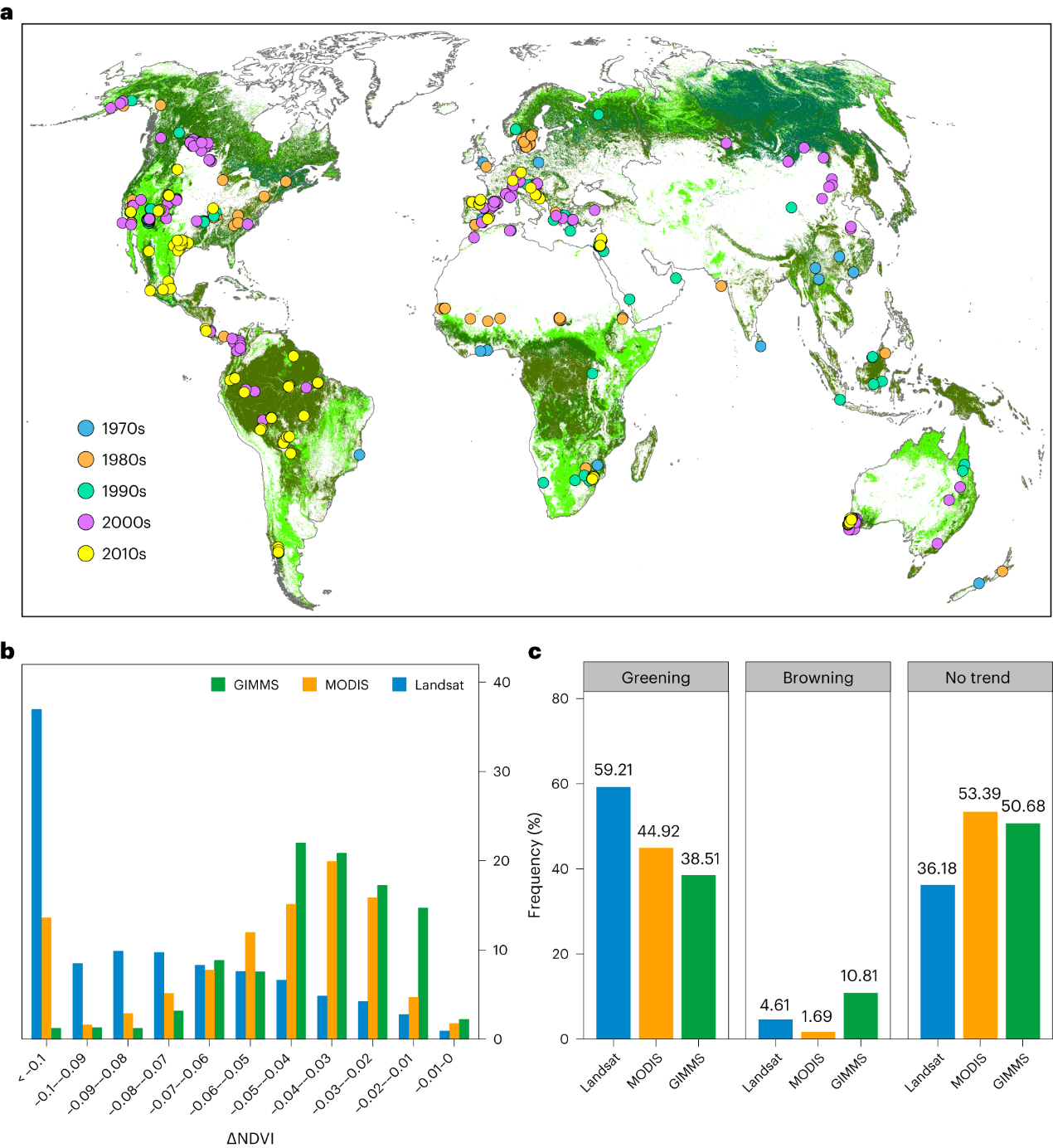文章来源: Yuchao Yan, Shilong Piao, William M. Hammond, Anping Chen, Songbai Hong, Hao Xu, Seth M. Munson, Ranga B. Myneni & Craig D. Allen. (2024). Climate-induced tree-mortality pulses are obscured by broad-scale and long-term greening. Nature Ecology & Evolution: 8, 912–923. https://www.nature.com/articles/s41559-024-02372-1.
整理人:徐嘉苗,2021级本科生
整理时间:2024年5月22日
Abstract: Vegetation greening has been suggested to be a dominant trend over recent decades, but severe pulses of tree mortality in forests after droughts and heatwaves have also been extensively reported. These observations raise the question of to what extent the observed severe pulses of tree mortality induced by climate could affect overall vegetation greenness across spatial grains and temporal extents. To address this issue, here we analyse three satellite-based datasets of detrended growing-season normalized difference vegetation index (NDVIGS) with spatial resolutions ranging from 30 m to 8 km for 1,303 field-documented sites experiencing severe drought- or heat-induced tree-mortality events around the globe. We find that severe tree-mortality events have distinctive but localized imprints on vegetation greenness over annual timescales, which are obscured by broad-scale and long-term greening. Specifically, although anomalies in NDVIGS (ΔNDVI) are negative during tree-mortality years, this reduction diminishes at coarser spatial resolutions (that is, 250 m and 8 km). Notably, tree-mortality-induced reductions in NDVIGS (|ΔNDVI|) at 30-m resolution are negatively related to native plant species richness and forest height, whereas topographic heterogeneity is the major factor affecting ΔNDVI differences across various spatial grain sizes. Over time periods of a decade or longer, greening consistently dominates all spatial resolutions. The findings underscore the fundamental importance of spatio-temporal scales for cohesively understanding the effects of climate change on forest productivity and tree mortality under both gradual and abrupt changes.
摘要:植被绿化已被认为是近几十年来的主要趋势,但干旱和热浪后森林树木死亡的严重脉冲也被广泛报道。这些观测结果提出了一个问题,即观测到的由气候引起的树木死亡的严重脉冲在多大程度上可以跨空间颗粒和时间范围影响总体植被绿度。为了解决这一问题,本文分析了三个基于卫星的非趋势生长季节归一化植被指数(NDVIGS)数据集,空间分辨率从30 m到8 km,涵盖了全球1303个经历严重干旱或热致树木死亡事件的实地记录站点。我们发现严重的树木死亡事件在年时间尺度上对植被绿度有独特但局部的影响,而这些影响被大尺度和长期绿化所掩盖。具体来说,尽管NDVIGS (ΔNDVI)在树木死亡年份的异常值为负值,但在较粗的空间分辨率(即250米和8公里)下,这种减少会减弱。值得注意的是,树木死亡率在30 m分辨率下导致的NDVIGS (|ΔNDVI|)减少与本地植物物种丰富度和森林高度呈负相关,而地形异质性是影响ΔNDVI不同空间粒度差异的主要因素。在十年或更长的时间里,绿化一直主导着所有的空间分辨率。这些发现强调了时空尺度对于连贯地理解气候变化在渐变和突变两种情况下对森林生产力和树木死亡率的影响的根本重要性。

图 全球森林死亡站点生长季归一化植被指数(NDVIGS)变化
注:a,全球1303个森林死亡站点分布。b,森林死亡事件发生年份生长季NDVIGS变异(ΔNDVI)的频率分布。c,全球森林死亡站点中各类型NDVIGS长期变化趋势占比。
原文链接:https://www.nature.com/articles/s41559-024-02372-1
节选转引:https://mp.weixin.qq.com/s/qcPrwQywhRbg2m2pg8m8nA